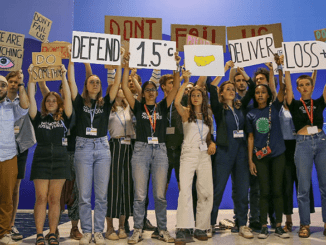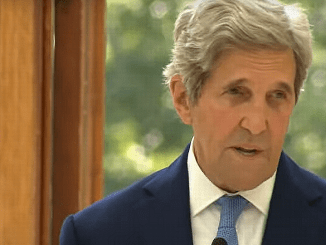
NORFOLK, Virginia, July 4, 2021 (ENS) – The U.S. Bureau of Ocean Energy Management, BOEM, is starting its environmental review for the Coastal Virginia Offshore Wind Commercial, or CVOW-C, project. This is a big deal because, if approved, it will be the first commercial offshore wind farm in Virginia’s Atlantic Ocean waters.
To announce this breakthrough in U.S. offshore wind permitting, Democratic leaders gathered in Norfolk, Virginia on Thursday. Secretary of the Interior Deb Haaland joined Virginia Governor Ralph Northam, and Senator Tim Kaine for a tour of the Port of Virginia, a world-class maritime facility that is being retrofitted to meet the needs of the region’s promising offshore wind industry.
Norfolk elected officials and representatives of the offshore wind industry were also on hand.
“The demand for offshore wind energy has never been greater. Recent technological advances, falling costs, and tremendous economic potential make offshore wind a promising avenue for diversifying our national energy portfolio, creating good-paying union jobs, and tackling climate change,” said Secretary Haaland.
“Today’s tour and meetings were a great chance to learn about the Commonwealth’s continued leadership role in developing the offshore wind industry and attracting and supporting the domestic supply chain,” she said.
CVOW-C is one of the first two offshore wind projects to be scheduled for an environmental review under a new agreement between BOEM and the U.S. Army Corps of Engineers that allows the Corps to provide BOEM with the additional scientific and technical resources needed to evaluate offshore wind projects on the Outer Continental Shelf.
While the scope of the agreement covers all renewable energy activities in the Atlantic, the initial focus will be on the environmental review of CVOW-C, as well as the Kitty Hawk project, proposed for offshore the Atlantic coast of neighboring North Carolina.
If approved, Kitty Hawk would be built 27 miles from the Outer Banks in an area designated by BOEM, which awarded the 122,405-acre lease to Avangrid Renewables in 2017. Once complete, Kitty Hawk Offshore Wind is projected to have a generation capacity of up to 2,500 megawatts, or enough to power approximately 700,000 homes.
Also located 27 miles offshore, the CVOW-C project off the coast of Virginia Beach would be owned and operated by Dominion Energy, becoming the first utility-owned offshore wind farm in the country.
CVOW-C’s two test wind turbines currently in operation there are the first installed in U.S. federal waters and are avoiding up to 25,000 tons of carbon dioxide emissions annually.
The CVOW-C project plans the construction and operation of up to 205 turbines capable of generating up to 3,000 megawatts of electricity, enough to power some 660,000 homes.
“Virginia is all in on offshore wind. We are developing the infrastructure, workforce, supply chain, and manufacturing capabilities needed to capture the many benefits of this emerging industry,” said Governor Northam.
“This announcement puts our Commonwealth on a path to harnessing the power of wind to produce affordable and reliable renewable energy, create thousands of new jobs, and meet our ambitious climate goals. We are grateful for the federal government’s partnership as we work to advance our clean energy future with this large-scale commercial wind project along Virginia’s coast.”
Featured image: CVOW-C’s two test wind turbines now operating 27 miles off the coast of Virginia are the first installed in U.S. federal waters. They are avoiding up to 25,000 tons of carbon dioxide emissions annually. (Photo courtesy Dominion Energy)
© 2021, Environment News Service. All rights reserved. Content may be quoted only with proper attribution and a direct link to the original article. Full reproduction is prohibited.



